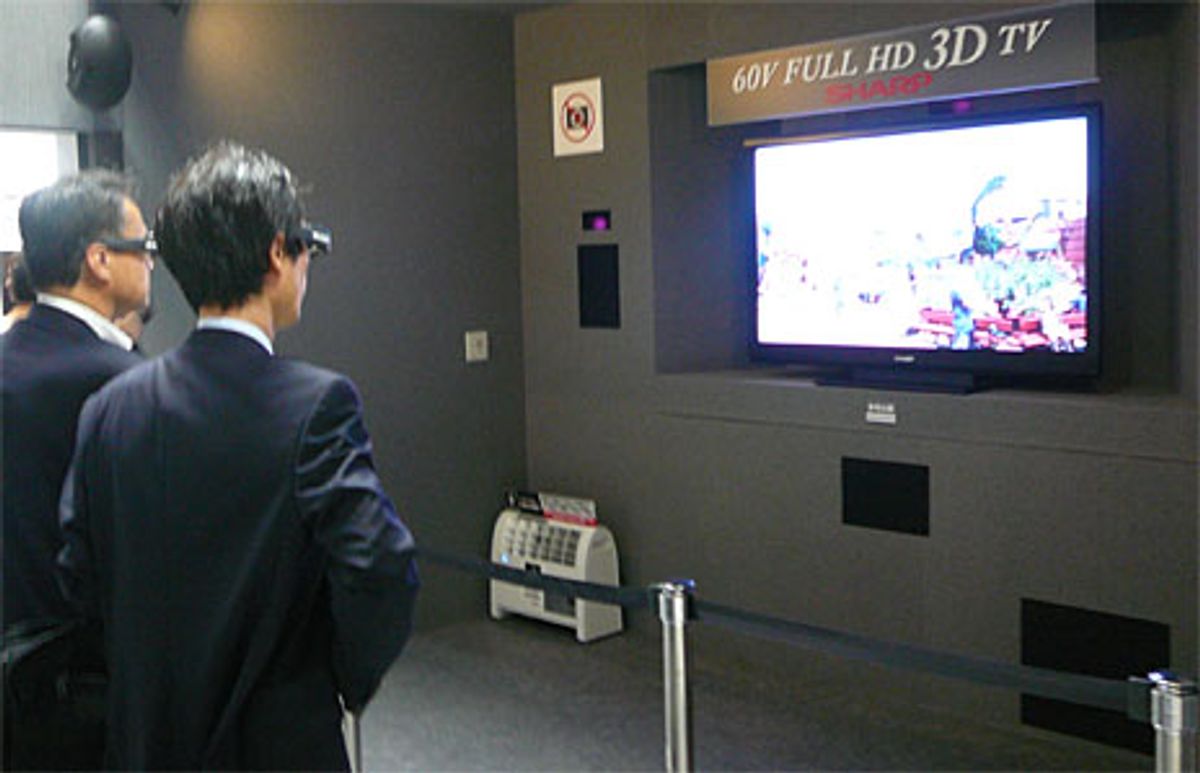13 October 2009—The 10th annual CEATEC show, Japan’s biggest yearly gathering for far-out gadgets and cutting-edge technologies, has certainly downsized a bit. The number of exhibitors fell to 590 this year from just over 800 in 2008, and the number of booths where firms hawk their high-tech wares fell by about 1000, down to 2123. But the size and scope of the new televisions and displays there haven’t diminished.
Ready or not, want it or not, the next big thing in home entertainment is three-dimensional TV, if Sony, Panasonic, Sharp, and Hitachi have anything to do with it. All had long lines of attendees waiting to watch carefully prepared 3-D segments of movies and video. Sony took it a step further, demonstrating a 3-D video game, recording sports live in 3-D, and showing off an image-splitting single-lens camera capable of filming 3-D content at 240 frames per second. The extravaganza underscored Sony’s desire to create a new 3-D business from TVs, projectors, content from Sony Pictures, and cameras.
The approach to 3-D that most of these companies have taken is to use polarized shutter glasses that open and close each of two lenses rapidly in sync with the TV’s refresh rate. Sony, for instance, employed shutter glasses to sync with a 3-D–enabled 52-inch (133-centimeter) 240-hertz Bravia LCD HDTV. Panasonic did the same with a 50-inch plasma display.
The short 3-D video offerings were colorful, vivid, and compelling. The sports segment from Sony in particular gave the feeling of being at the event. But in general, I found the transition from one scene to the next to be sudden and slightly disconcerting, suggesting that the manufacturers still have some refining to do before the promised products arrive next year.
Click on image for larger view.
Missing from the 3-D roll call was Toshiba. Instead, it is going after the high-end TV market by using its Cell microprocessor technology, which the company originally developed with IBM and Sony. While Sony uses the Cell chip to power its PlayStation 3 video-game console, Toshiba has long been searching for ways to make practical use of the technology’s asymmetric multicore power.
At CEATEC, Toshiba announced the first TV to use the Cell chip, the Cell Regza, which will go on sale in Japan at the beginning of December. The specs help explain why the 55-inch LCD HDTV demonstration models looked so good when compared with standard models at the show. The Toshiba TV boasts a dynamic contrast ratio of 5 000 000 to 1; a dedicated processor to improve image quality at the edge of the picture; optimized control of LED backlighting, which is divided into 512 discrete areas; and a 3-terabyte hard disk. The Cell chip uses two of these terabytes to provide simultaneous recording in full HD of up to eight TV channels, for a total of 26 hours of programming. The Cell chip and other components are housed in a separate set-top box. When it’s released in the United States next year, the TV will cost around $11 000 (based on 90 yen to the U.S. dollar).
Organic light-emitting diode (OLED) displays have been steadily improving in recent years, and Mitsubishi Electric Corp. is the latest manufacturer to demonstrate their progress. At CEATEC, the company showcased a scalable 155-inch (394-cm) prototype OLED display that will target the digital signage market when it is commercialized in the next two to three years.
The display is made up of OLED panels measuring 96 by 96 millimeters each. The panels can be tiled together to make displays of any size and in curved or angled designs if required. Satoshi Tanaka, a manager in Mitsubishi’s image and information systems department, says the merits of using OLED technology are that the panels are “thin, lightweight, scalable, and fit together seamlessly, as well as providing high brightness and contrast.”
About the Author
John Boyd writes about science and technology from Japan. In June 2009, he reported on a wireless 1000-year data-storage system.




